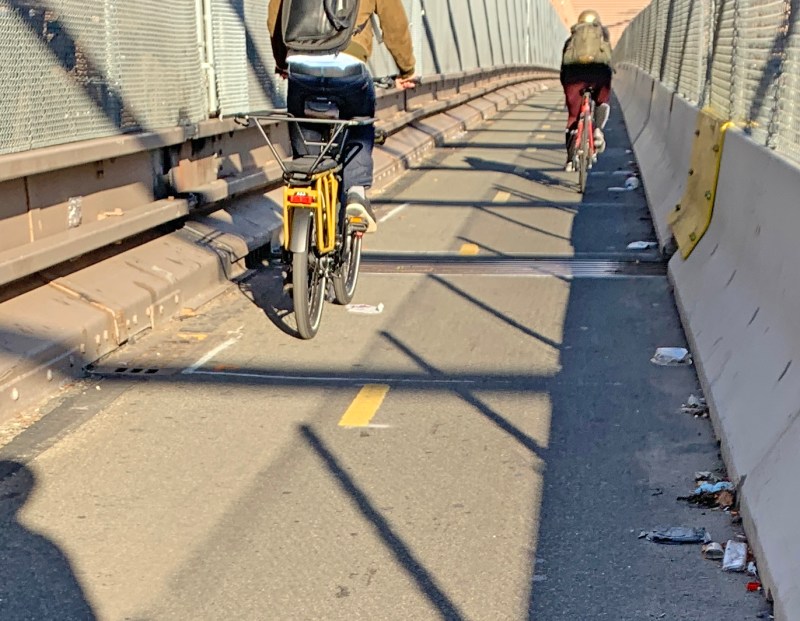Drivers, Pedestrians are Already Trashing the Brooklyn Bridge Bike Path

It’s a bridge to mar.
The newly opened Brooklyn Bridge bike path — which the Department of Transportation says is a huge hit with cyclists — is already being defiled with garbage that’s either cascading down from the pedestrian path or tossed by drivers over the short fence from the car lanes.
The DOT has confirmed that the agency, and not the Department of Sanitation, is responsible for clearing the lane (which applies to snow season, too), but the agency declined to answer specific questions about how often the lane will be cleaned, what the plan is for winter, and if the agency has sufficient resources and equipment to do the job consistently.
(Update: After initial publication of this story very early on Friday morning, the DOT sent over a statement, “The new protected path was cleaned Thursday night — and it will be cleaned regularly going forward, every other week and more often as needed. We thank Streetsblog for flagging.”)
Readers of Streetsblog will remember how roadways, bus stops and bridge bike paths have been cleared inconsistently during winter time. (Some roadways are the responsibility of DSNY, but bridge bike paths and some bike lanes are the responsibility of DOT, as we demonstrated here here here and here.)
Regardless of the agency’s plans going forward, it is currently a dumping ground. Here’s a slideshow from this week:
Former city transportation official Jon Orcutt said he was not too concerned about the DOT’s ability to handle snow when (or if) winter ever comes because the DOT already clears the roadway lanes of the fabled span and will be able to do the bike lane because it has the right equipment (unlike the Sanitation Department, as we reported).
“The big bridges are well tended during snow — immeasurably so compared to streets,” said Orcutt, who now works for Bike New York. “Unlike the Sanitation Department, DOT’s bridge division has sweeping equipment right-sized for bikeways and greenways.”
But he added that if trash is gathering in the bike path now, it’s “time to get out there and give it a scrub!” (A complaint of trash in a bike lane can only be made by calling 311, not via the 311 app or website.)
But the main concern of people who study how snow is removed is that the city’s official, stated, ratified and approved plan for removing snow requires the various agencies to clear car lanes first, which you know from reading the Sanitation Department’s snow-removal plan for 2020-21:
After salting and plowing operations [in the car lanes] have stopped, DSNY addresses snow and ice removal from bike lanes, pedestrian overpasses and step streets, bus stops and crosswalks.
The DSNY’s snow plan for 2021-22 will be published on its website on Nov. 15 after the ongoing review by the outgoing council. (The agency told Streetsblog that it will lease better, narrower snow-removal equipment this season, as a way to test it before making larger purchases.)
It is unclear if the DOT has a version of DSNY’s “cars first” rule for roadways — such as the Brooklyn Bridge — under its control, but it is something to look out for as the weather turns cooler and some people predict a harsh winter.
Eric McClure of StreetsPAC suggested that the bridge design itself is going to be a problem if Old Man Winter ever shows up.
“There doesn’t seem to be anywhere to push snow except out either end, so in addition to it being generally a good thing to keep the path clear of trash and debris, it would be good practice for handling snow removal,” he said. “Might be a good place for the city to pioneer radiant heating for snow melting.”
Cyclists definitely enjoy the Brooklyn Bridge bike path, according to DOT officials. At a press conference earlier this month, DOT’s Sean Quinn said the agency’s preliminary numbers suggest that there are more cyclists on the path, but without a commensurate drop in ridership over the nearby Manhattan Bridge. Quinn said he would present more complete numbers later this month, after the agency sifts out riders who just took the Brooklyn Bridge bike path once or twice just to see it, rather than to use it on a regular commute.

